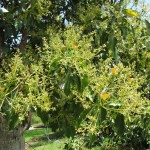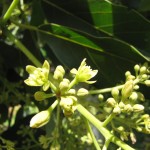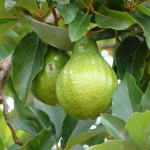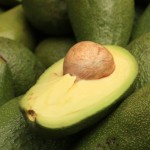Species: Persea americana
English Name: Avocado
Chinese Name: 鱷梨、油梨、樟梨
Family: Lauraceae
Description:
Evergreen trees, ca. 10 m tall. Bark gray-green, longitudinally fissured. Leaves alternate; petiole 2-5 cm, slightly sulcate adaxially, sparsely pubescent; leaf blade usually somewhat glaucous abaxially, green adaxially, narrowly elliptic, elliptic, ovate, or obovate, 8-20 × 5-12 cm, leathery, sparsely yellowish brown pubescent adaxially but very densely so abaxially when mature, midrib conspicuously elevated abaxially, impressed on lower part but plane on upper part adaxially, lateral veins 5-7 pairs, very elevated abaxially, slightly elevated adaxially, base cuneate or acute to subrounded, apex acute. Cymose panicles 8-14 cm, most of them inserted on lower part of branchlet, pedunculate; peduncle 4.5-7 cm, peduncle and rachis densely yellowish brown pubescent; bracts and bracteoles filiform, ca. 2 mm, densely yellowish brown pubescent. Pedicels up to 6 mm, densely yellowish brown pubescent. Flowers yellow-greenish, 5-6 mm. Perianth densely yellowish brown pubescent outside and inside; perianth tube obconical, ca. 1 mm; perianth lobes 6, oblong, 4-5 mm, obtuse, outer 3 smaller, all dilated after anthesis and caducous. Fertile stamens 9, ca. 4 mm; filaments filiform, complanate, densely pilose, those of 3rd whorl each with 2 complanate ovate and orange glands at base, others glandless; anthers 4-celled; cells introrse in 1st and 2nd whorls, extrorse in 3rd whorl. Staminodes 3, of innermost whorl, sagittate-cordate, ca. 0.6 mm, glabrous, stalked; stalk ca. 1.4 mm, pilose. Ovary ovoid, ca. 1.5 mm, densely pilose; style ca. 2.5 mm, densely pilose; stigma slightly dilated, discoid. Fruit yellow-green or reddish brown, large, usually pear-shaped, sometimes ovoid or globose, 8-18 cm; exocarp corky; mesocarp fleshy and edible. Fl. Feb-Mar, fr. Aug-Sep.




Photos used under a Creative Commons license
References:
Wu ZY, Raven PH, Hong DY (eds) (2011) Flora of China. Vol. 19 (Cucurbitaceae through Valerianaceae, with Annonaceae and Berberidaceae). Science Press, Beijing, and Missouri Bot Garden Press, St. Louis

